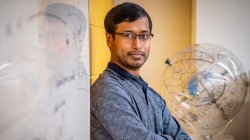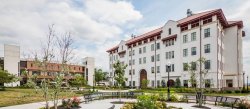Professor Ghosh awarded $150k NSF grant to connect gravitational waves and electromagnetic astronomy
Shaon Ghosh, an assistant professor in the Physics & Astronomy Department, was recently awarded a National Science Foundation (NSF) research grant.
Posted in: Awards & Recognition, CSAM Research, Physics & Astronomy

His grant, titled “RUI: WoU-MMA: Multi-Messenger Astronomy and Astrophysics with Gravitational-Wave Data,” provides $150,000 over three years of support. Ghosh is a member of the LIGO Scientific Collaboration, an international team that observes collisions of neutron stars and black holes throughout the universe using the Laser Interferometer Gravitational-wave Observatory (LIGO).
As part of the grant, Ghosh will improve the computer analysis that identifies those gravitational-wave signals that may also produce light (or EM) emission. These are most likely collisions involving neutron stars—incredibly dense stellar remnants formed after heavy stars end their life cycle. While composed mostly of neutrons, there are aspects of their composition that are not understood. In another aspect of Ghosh’s grant-funded work, he will attempt to better constrain the composition of these neutron stars, based on the results of LIGO observations.
We are at the threshold of an exciting time. The next observing period of the LIGO-Virgo-Kagra collaboration is expected to triple the rate of gravitational-wave observations. Gravitational wave detectors will march towards their design sensitivity in the next few years. This grant will support work that will address the development of computational infrastructure that can handle the high rate of detections that the current infrastructure is incapable of handling.
In addition to these research goals, the grant will also help to fund student research opportunities and outreach efforts. In particular, Ghosh will focus on training students in techniques that involve machine learning and handling large data sets.
Ghosh is a leader in the LIGO team’s effort to rapidly analyze gravitational-wave “triggers’’ seen by the detectors, and then relay those potential events (representing cosmic collisions) to other astronomers. Those astronomers will then follow-up the triggers by pointing electromagnetic (EM) telescopes at the possible sky positions indicated by LIGO and its partner detectors (Virgo in Italy and KAGRA in Japan). Because optical, radio, x-ray, and other EM telescopes are observing a completely different kind of emission than gravitational-waves, there is the potential to learn an incredible amount of information from objects observed with both kinds of signals. So far, only one event was observed with both gravitational-waves and light—the binary neutron star collision GW170817. It remains among the most studied transient objects in the history of astronomy.
“Professor Ghosh has taken on a leadership role in the LIGO Collaboration, and we were very happy to have him join us last year,” says Marc Favata, chairperson of the Physics & Astronomy Department. “This grant will support his important work—which is key to helping LIGO achieve some of its science goals. It will also help provide our students with valuable research opportunities, training them in some of the most in-demand computing and data science skills.”
For more information on the Department of Physics and Astronomy at Montclair State University, visit montclair.edu/physics-astronomy/.
